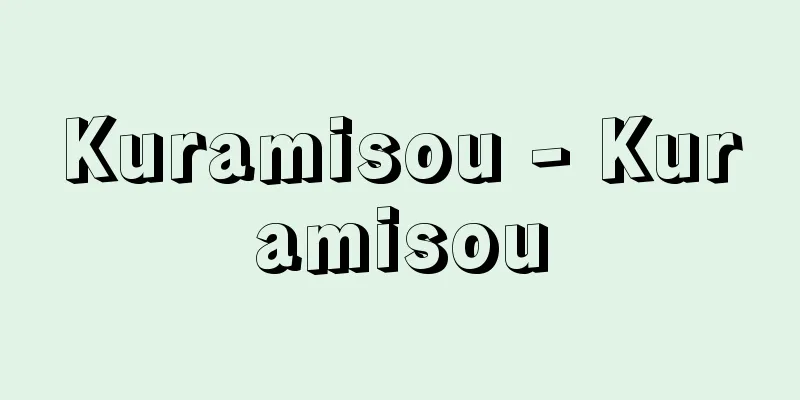Big Mouth - Ookuchi

[1] 〘 noun 〙 (also "ooguchi") [一]① A big mouth. A mouth that is wide open. ※Uji Shui (around 1221) 2 "Looking at this rock , it really looks like a dragon opening its mouth."② Lewd talk. Obscene talk. A big-mouthed story. ※Ukiyo- zoshi: Amorous Life of a Woman (1686) 1 "The man, wearing only loincloths and with the maid in front of him, became so excited that he couldn't help but talk big."③ To say something exaggerated. To blurt out whatever one wants to say. ※Gyokujin-sho (1563) 19 "There was a man named Wang Chong. He said that in the east, he would close the Kankoku Pass and buy the gates. He was a big mouth."④ A large amount or number of purchases, sales, etc. ⇔ Small amount. ※Hamo no kawa (Hamo no kawa) (1914)〈Ushio Shoken〉1 "The o-guchi of the front teahouse, which is said to serve forty people, has been cooked, and twelve groups of guests on the second floor have also been served."⑤ A type of tea ceremony utensil. Similar to a katakuchi, it has no handle and a wide mouth. It is used to pour water into kettles and water pitchers. [2] (Abbreviation of "okuchi bakama") This refers to hakama with a wide opening at the hem. O-guchi hakama. ① A type of under-bakama. Used as footwear under the outer hakama when wearing sokutai . Made from plain silk or fine silk , it is usually dyed red, but elderly people leave it white. Red o-guchi. Red hakama. ※Makura (End of the 10th century) 134 "The opening is wider than the long one, so it is only natural."② A type of under-bakama. It is worn under sashi -nuki or hitatare hakama. The front is made of sei-gō and the back is made of ō - sei-gō , and the back is stretched. Komio -okuchi. Ushiobari ō-guchi . In Furyu , the upper hakama is omitted, and this style has been passed down to Noh costumes. *Takakurain Itsukushima Goko-ki (Record of a Visit to Itsukushima) (1180) "They wear various flowers, ō-kuchi, and perform dengaku." ③ Hakama worn when wearing a child-like costume and the half- buttocks are required. The front is made of ō-sei-gō and the back is made of sei-gō. Saibari ō -guchi . Maebari. ④ One type of Noh costume. Hakama with strong stretch on both sides at the back. Made from raw silk. According to the color of the fabric, they are divided into white okuchi, scarlet okuchi, colored okuchi with a background color other than scarlet, and patterned okuchi. They are used according to the role of the minister, monk, warrior, woman, etc. ※Sarugaku Dangi (1430) Noh coloring "In the side Noh, the minister should first be made of water and sewage. The minister is accompanied by an okuchi." ⑤ One of the costumes of Kabuki. Hakama taken from Noh costumes. It is often used in Matsubamemono (a type of play that imitates the style of Noh) . [Nippo Jisho (1603-04)] ⑥ Backstage slang for trousers or patches in the theater world. [2] The name of a place in northern Kagoshima Prefecture. It is a key transportation point leading to Miyazaki and Kumamoto Prefectures, and was under the direct control of the Shimazu clan during the Edo period. Ushio flourished as a gold mining town, but is now closed. It was incorporated as a city in 1954 .O- guchi (large mouth)Source: The Selected Edition of the Japanese Language Dictionary About the Selected Edition of the Japanese Language Dictionary Information |
[1] 〘名〙 (「おおぐち」とも)[一]① 大きな口。大きくあいた口。※宇治拾遺(1221頃)二「この磐(いはほ)を見るに、誠に龍の大口を明きたるに似たり」② みだらな話。猥談(わいだん)。おおぐちばなし。※浮世草子・好色一代女(1686)一「ふんどしかきながら女中同前の男、心のうき立程、大口(オホグチ)いふより外はなし」③ おおげさなことを言うこと。言いたいほうだいに言いちらすこと。※玉塵抄(1563)一九「王充と云者あり〈略〉東の方は函谷関とぢてふうじかためてをかうと云たぞ、大口なことぞ」④ 売買や取引などの額や数がまとまって多いこと。⇔小口。※鱧の皮(1914)〈上司小剣〉一「四十人前といふ前茶屋の大口が焼き上って、二階の客にも十二組までお愛そを済ましたので」⑤ 茶道具の一種。片口に似て、柄がなく口が広いもの。釜や水指しに水を入れるのに用いる。[二] (「おおくちばかま(大口袴)」の略) 裾の口が広い袴をいう。大口の袴。① 下袴の一種。束帯の時に表袴(うえのはかま)の下のはきものとして用いる。平絹(へいけん)・精好(せいごう)の類で仕立てて、赤染めを普通とするが、老人は白のままとした。赤大口。赤袴。※枕(10C終)一三四「おほぐち、またながさよりは口ひろければ、さもありなん」② 下袴の一種。指貫(さしぬき)や直垂(ひたたれ)の袴の下にはく。前面を精好、後面を大精好(おおせいごう)で仕立てて、後腰(うしろごし)を張らせて着用する。込大口(こみおおくち)。後張(うしろばり)の大口。風流(ふりゅう)の時は上の袴を省略して用い、能装束の着用にその様式を伝えている。※高倉院厳島御幸記(1180)「さまざまの花をつけて、大くちを着て、田楽つかうまつる」③ 童形装束で半尻(はんじり)所用の時にはく袴。前面を大精好、後面を精好で仕立てる。前張(さいばり)の大口。前張。④ 能装束の一つ。後部を左右に強く張った袴。生絹でつくる。生地の色で、白大口、緋大口、緋以外の色を地とする色大口、模様大口などに分けられ、大臣・僧・武将・女など、それぞれの役柄によって使い分けをする。※申楽談儀(1430)能の色どり「脇の能、大臣には、先は、上下水干成べし。つれ大臣は大口也」⑤ 歌舞伎の衣装の一つ。能装束からとった袴。能の形式を模した松羽目物(まつばめもの)に多く用いられる。〔日葡辞書(1603‐04)〕⑥ 股引き、パッチをいう、演劇社会の楽屋言葉。[2] 鹿児島県北部の地名。宮崎、熊本両県に通じる交通の要地で、江戸時代は島津氏の直轄地。牛尾は金山の町として栄えたが、現在は閉山。昭和二九年(一九五四)市制。
おおぐち おほぐち【大口】出典 精選版 日本国語大辞典精選版 日本国語大辞典について 情報 |
Recommend
total fertility rate
…There are some significant differences in the tr...
Seller monopoly - Urite dokusen
...A seller's monopoly is a type of monopoly ...
《Ishiba Shiyaim》 - Ishiba Shiyaim
The scriptures cover a wide range of subjects, in...
Üsküdar (English spelling)
It is one of the five districts of Greater Istanbu...
Khursabad - Khursabad (English spelling)
The ruins are located in northern Iraq, about 20 ...
Citric Acid Cycle
Also known as the TCA cycle, Krebs cycle, tricarbo...
Kazuo Asukata
Politician. Born in Yokohama. Graduated from Meij...
Snuff - Snuff
Snuff is a powdered tobacco that you rub against y...
Freeholder (English spelling)
Freeholders. A class of freehold landowners since ...
Toompea
…A port on the Gulf of Finland, it is the politic...
Brahma (English spelling)
…One of the main gods of Hinduism. A transliterat...
panoramic camera
…Single-lens reflex cameras with the most common ...
Kishishu - Kishishu
…The most common number of beads is 108, but acco...
Aloe-emodin (English spelling) aloe-emodin
…The folk medicine Aloe vera was introduced to Ja...
Square seal - Kakuin
...The size of a seal that can be registered is s...








![Suki [Village] - I like it](/upload/images/67cbf32ca4307.webp)
